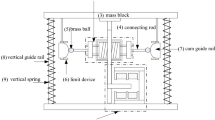Abstract
The most important characteristic of a passive vibration isolator is its natural frequency and load capacity. The vibration isolation performance of a passive vibration isolator in low input frequencies is considerably improved by reducing its natural frequency. This paper presents a negative stiffness magnetic suspension vibration isolator (NSMSVI) using a magnetic spring combined with rubber membranes to obtain lower natural frequency. To study the vibration isolation performance of the NSMSVI, the stretching force of the rubber membrane is measured through experiments. The stiffness of the rubber membrane comes from the derivative of the stretching force. A parametric study of load capacity, axial magnetic stiffness, and natural frequency of the magnetic spring is also performed. Consequently, as a case study, the size dimensions of the magnetic spring are determined. An NSMSVI table is set up for experimental validation, after which the transmissibility curves of the NSMSVI are calculated and tested. Experimental results show that the lowest natural frequency of the NSMSVI reaches 1.5 Hz with a maximum attenuation of -40 dB between 0 Hz and 100 Hz, whereas the NSMSVI has the maximum load capacity at the lowest stiffness. This paper essentially provides an efficient method to construct a negative stiffness vibration isolator for practical applications.
Similar content being viewed by others
References
C. Erin and B. Wilson, An improved model of a pneumatic vibration isolator: theory and experiment, Journal of Sound and Vibration, 218(1) (1998) 81–101.
M. Golam Mostofa, J. H. Noh, H. Y. Kim, J. H. Ahn and D. B. Kang, Tooling device design for vibration-assisted high speed shaping of PMMA, Journal of Mechanical Science and Technology, 24(8) (2010) 1623–1629.
I. Kovacic, M. J. Brennan and T. P. Waters, A study of a nonlinear vibration isolator with a quasi-zero-stiffness characteristic, Journal of Sound and Vibration, 315(3) (2008) 700–711.
D. L. Platus, Negative-stiffness-mechanism vibration isolation systems, In Proceeding of SPIE, -Vibration Control in Microelectronics, Optics and Metrology, 44 (1991) 44–54.
J. Z. Zhang, S. Dong and D. Li, Study on new type vibration isolation system based on combined positive and negative stiffness, Nanotechnology and Precision Engineering, 2(4) (2004) 314–318.
T. D. Le and K. K. Ahn, A vibration isolation system in low frequency excitation region using negative stiffness structure for vehicle seat, Journal of Sound and Vibration, 330(26) (2011) 6311–6335.
C. M. Lee and V. N. Goverdovskiy, A multi-stage-high railroad vibration isolation system with “negative stiffness, Journal of Sound and Vibration, 331(4) (2012) 914–921.
A. Carrela, M. J. Brennan and T. P. Waters. Optimization of a quasi-zero-stiffness isolator, Journal of Mechanical Science and Technology, 21(6) (2007) 946–949.
A. D. Angola, G. Carbone and L. Mangialardi, C. Serio, Non-linear oscillations in a passive magnetic suspension, International Journal of Non-linear Mechanics, 41(9) (2006) 1039–1049.
E. Bonisoli and A. Vigliani, Passive elasto-magnetic sus-pensions: nonlinear models and experimental outcomes, Mechanics Research Communications, 37(4) (2007) 385–394.
J. Kim, K. H. Sun, W. Kim and J. E. Kim, Magnetic torque maximization in camera shutter module by the topology optimization, Journal of Mechanical Science and Technology, 24(12) (2010) 2511–2517.
T.-W. Kim, D.-M. Kang and J.-S. Kwak, Application of magnetic abrasive polishing composite materials, Journal of Mechanical Science and Technology, 24(5) (2010) 1029–1034.
S. Yoo, W. Lee, Y. Bae and M. Noh, Design of magnetically levitated rotors in a large flywheel energy storage from a stability standpoint, Journal of Mechanical Science and Technology, 24(1) (2010) 231–235.
E. Puppin and V. Fratello, Vibration isolation with magnet springs, Review of Scientific Instruments, 73(11) (2002) 4034–4036.
K.-B. Choi, Y. G. Cho, T. Shishi and A. Shimokohbe, Stabilization of one degree-of-freedom control type levitation table with magnet repulsive forces, Mechatronics, 13(6) (2003) 587–603.
W. Roberson, B. Cazzolato and A. Zander, Theoretical analysis of a non-contact spring with inclined permanent magnets for load-independent resonance frequency, Journal of Sound and Vibration, 331(6) (2012) 1331–1341.
A. Carrella, M. J. Brennan, T. P Waters and K. Shin, On the design of a high-static-low-dynamic stiffness isolator using linear mechanical springs and magnets, Journal of Sound and Vibration, 315(3) (2008) 712–720.
J. P. Yonnet, Permanent magnet bearings and couplings, IEEE Transaction on Magnetics, 17(1) (1981) 1169–1173.
Y. Zhu, Q. Li, D. Xu and M. Zhang, Modeling of axial magnetic force and stiffness of ring-shaped permanent magnets passive vibration isolator and its vibration isolating experiment, IEEE Transaction on Magnetics, 48(7) (2012) 2228–2238.
A. Dorfmann and R. W. Ogden, A constitutive model for the mullins effect with permanent set in particle-reinforce rubber, International Journal of Solids and Structures, 41(7) (2004) 1855–1878.
E. Verron and G. Marckmann, Inflation of elastomeric circular membranes using network constitutive equations, International Journal of Non-linear Mechanics, 38(8) (2003) 1221–1235.
A. P. S. Selvadurai, Deflections of a rubber membrane, Journal of the Mechanics and Physics of Solids, 54(6) (2006) 1093–1119.
S. Earnshaw, On the nature of the molecular forces which regulate the constitution of the luminiferous ether, Transaction of the Cambridge Philosophical Society, 7 (1842) 97–112.
Author information
Authors and Affiliations
Corresponding author
Additional information
Recommended by Associate Editor Jun-Sik Kim
Qiang Li received his B.S. Degree in Car Design from the Henan University of Science and Technology, Luoyang, China, in 1999. He received his M.S. Degree in Mechanical Engineering from Northwestern Polytechnical University, Xi’an, China, in 2007. He is currently a Ph.D. student at the Department of Precision and Mechanology, Institute of Manufacturing Engineering, Tsinghua, University, Beijing, China. His research interests include vibration isolators and structural dynamics.
Rights and permissions
About this article
Cite this article
Li, Q., Zhu, Y., Xu, D. et al. A negative stiffness vibration isolator using magnetic spring combined with rubber membrane. J Mech Sci Technol 27, 813–824 (2013). https://doi.org/10.1007/s12206-013-0128-5
Received:
Revised:
Accepted:
Published:
Issue Date:
DOI: https://doi.org/10.1007/s12206-013-0128-5




